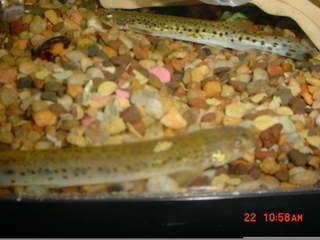Page 1 of 1
S.Taxistigma
Posted: 13 Jan 2006, 00:02
by cichlidnut
have any of you guys had Stegophilus Taxistigma and if so can give me some info on them like how big they get and what they eat?
Posted: 13 Jan 2006, 09:03
by djw66
If memory serves, all Stegophilus sp. are obligate parasites. Thus, they eat the blood and mucus of live fish, and nothing else.
Dave
Posted: 24 Jan 2006, 21:34
by cichlidnut
this is a photo of the cats

Posted: 25 Jan 2006, 18:26
by sidguppy
If those are yours, better prepare for some truly nasty feedingbusiness.
they look a LOT like the Ochmacanthus I kept many years ago and that one made the life of the other cats in my then 132G riverine tank sheer hell. It was a by-catch in some very unusual mixed catfish-shipment and I was allowed to take it home.
I took it, making the mistake of assuming that parasitic Trichomycterids should look like transparant things like Tridensimilis or extremely elongate like Vandellia.
I thought the cameo pattern made it a regular bottomdwelling type instead of some semi-internal parasitic gillsucker.
lightning fast and well capable of ripping scales and/or mucus of any fish; small, big, slow, fast, armoured or 'naked'; you name it.
Posted: 25 Jan 2006, 18:47
by Marc van Arc
sidguppy wrote:
they look a LOT like the Ochmacanthus I kept many years ago
They may easily be of the same species as the one you had; Stegophilus taxistigma used to be called Ochmacanthus (taxistigma) in those days.
Posted: 25 Jan 2006, 20:09
by sidguppy
Perhaps, but mine was shaped similar but the pattern was a bit darker colored and less clear spots than these; more cameo-pattern as well.
The first one in the catelog looks very similar to that one I had, though, mine was less transparant.
But I believe right away that fish like these critters can and do change their pattern and coloration at the drop of a hat; it was virtually invisible when half buried in a sand/fine gravel mix......
Posted: 29 Jan 2006, 18:37
by cichlidnut
sidguppy wrote:If those are yours, better prepare for some truly nasty feedingbusiness.
they look a LOT like the Ochmacanthus I kept many years ago and that one made the life of the other cats in my then 132G riverine tank sheer hell. It was a by-catch in some very unusual mixed catfish-shipment and I was allowed to take it home.
I took it, making the mistake of assuming that parasitic Trichomycterids should look like transparant things like Tridensimilis or extremely elongate like Vandellia.
I thought the cameo pattern made it a regular bottomdwelling type instead of some semi-internal parasitic gillsucker.
lightning fast and well capable of ripping scales and/or mucus of any fish; small, big, slow, fast, armoured or 'naked'; you name it.
do you know how big they get?
Posted: 29 Jan 2006, 19:55
by Marc van Arc
cichlidnut wrote:do you know how big they get?
I wanted to look it up for you, but Mergus Wels Atlas 1 explicitely states that they don't give any information on care, because (quote) "this is NO aquarium fish".
This doesn't have anything to do with length, but with it's feeding behaviour, as stated above.
Posted: 29 Jan 2006, 20:55
by Shane
Here is an article I wrote on keeping them. A very tough fish to keep over the long haul.
http://www.planetcatfish.com/shanesworld/301.PHP
-Shane
Posted: 29 Jan 2006, 22:05
by sidguppy
Mine was small.
It was about 4 cm, and thin, but not as thin as a Vandellia; say, about 5 mm high at the base of the tail, and 6mm wide at the very flat head.
The Ochmacanthus I kept was a slime/mucus feeder. best proof for that was that it actually preferred to attack the larger catfishes in the tank (wich ofcourse have no scales) and almost ignored the barbs (although even they got its' attention).
it was by far the smallest fish in the tank, so I couldn't recreate Shane's experience.
any Zebra Danio or White Cloud Minnow would have been eaten by the Barilius or the Spiny Eel in there.
it's favourite host (preysounds silly, it was much bigger) was a 1+ foot Pterodoras granulosus.
maybe you know this fish: it's a huge Doradid with a particular leathery skin, almost like rubber. but every skin is covered in mucus, and pretty soon I observed very restless behaviour about this usually lumbering, gentle giant and white crescent-shaped marks, especially on the head and sides, like a miniature pleco grazed it.
There were only a Bristlenose pair and Sturisoma's in there...all adults. Once I spotted the "little brown devil" attacking the other fish (right down to adult 3-4" Pareutropius buffei), even armoured Callichthys I knew what happened.
Like Marc I can only say: NOT an aquariumfish.
Posted: 29 Jan 2006, 23:59
by cichlidnut
good looking out guys that info help me out alot

do you think that I can get them to breed?
Posted: 30 Jan 2006, 01:17
by Shane
do you think that I can get them to breed?
See how long you can keep them alive first. There are no recorded spawnings of trichomycterids that I am aware of.
-Shane
